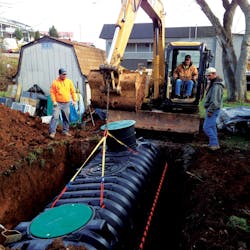Small System Solutions
The low-pressure sewer system in Surgoinsville, Tenn., delivers wastewater to the neighboring city of Church Hill's wastewater plant.
Finding cost-effective sustainable solutions for wastewater infrastructure challenges is a balancing act for rural and growing communities. Centralized sewering is cost intensive and impractical in areas without access to a wastewater treatment plant (WWTP) connection or in areas with insufficient infrastructure or funding to offset the significant cost of sewering to residents and businesses. In rural and suburban areas, decentralized treatment utilizing individual onsite septic systems and community systems can be the solution of choice.
One in every three U.S. homes is served by an individual onsite septic system. These systems provide long-term wastewater treatment performance at an affordable cost. Advanced system designs, modular products, and lightweight, high-strength plastic septic tanks enable individuals and communities to effectively protect resources and public health.
Decentralized Choice
Where individual onsite septic systems are the norm, town officials have a host of traditional and advanced decentralized treatment system possibilities to protect local waterways and water supplies, upgrade outdated systems to reduce nitrogen loading, and improve overall wastewater management for the community. Communities that choose a sustainable development and wastewater treatment path base the choice on community planning, anticipated growth, economics and environmental sensitivity. It is a boost to rural and growing communities that the wastewater technologies and solutions available for large-scale decentralized systems are now available for small-scale systems, as well.
STEP Systems
Communities without public sewer systems or adequate onsite septic systems to employ decentralized strategies can tie into an existing neighboring centralized WWTP with the installation of septic tank effluent pump (STEP) systems to upgrade individual onsite treatment systems.
Surgoinsville, Tenn., is a low-income community in northeastern Tennessee with a population of 1,800, no public sewer system and limited economic development opportunities. Existing homes had failing or compromised subsurface sewage disposal systems, and the current package plant was at the end of its useful life. Grants or loans from the Rural Development Community Program, Appalachian Regional Commission, U.S. Environmental Protection Agency, and U.S. Department of Agriculture Rural Development enabled a $4.5 million project that serves 247 residences, two schools and nine businesses. Installed on lots with existing homes, outbuildings, driveways and landscaping, the project is designed to serve 700 properties. The sewer system delivers wastewater to the neighboring city of Church Hill’s wastewater plant via 9 miles of low-pressure sanitary sewer collection lines, two pump stations and individual STEP services utilizing Infiltrator IM-1060 plastic tanks at more than 200 residences.
Onsite Technology & Design
In a most cases, wastewater is still being treated via individual onsite septic systems and returned to the groundwater. With proper design and maintenance, these systems offer long-term, effective performance on even the smallest, sloping and environmentally sensitive sites.
The existing septic system at the Lodge at Tupper Lake in New York state was undersized to handle the proposed flow from a renovation. Material delivery to the lakeside property was challenging and there was no option to connect to a centralized sewer. All wastewater collection and treatment needed to be completed on site while keeping the sensitive lake environment foremost in the design.
A stone and pipe absorption bed system was originally designed; however, barging stone and heavy equipment to the site was not an option. The engineer redesigned the 990-gal-per-day system using Infiltrator Quick4 Equalizer 36 Chambers in a 20-ft-wide-by-50-ft-long bed with four observation ports near the corners. Using the lightweight, open-bottom plastic chambers eased delivery to the remote site, offered increased soil infiltration, and enhanced aeration and filtration in the native sandy soils.
Three Treatment Questions
A few questions that community leaders and residents can contemplate before determining the most beneficial approach to take include:
- What is the current wastewater treatment challenge(s)?
- How do the projections for community growth impact anticipated wastewater treatment needs?
- What are the true costs?
Decentralized systems offer many benefits for small residential or community applications, and the best approach varies from case to case. Community leaders and residents need to define the community’s environmental challenges and anticipated growth in making the best wastewater treatment choice. Local codes, proximity to water bodies and anticipated daily flows are additional key factors for individual, commercial or community systems. In most cases, the decentralized approach can offer lower costs, high performance and versatility when compared to a centralized option.
